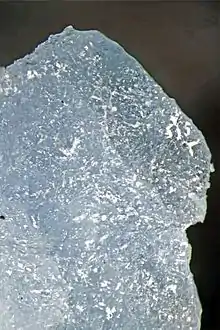Kogarkoite
Kogarkoite is a sodium sulfate fluoride mineral with formula Na3(SO4)F. It has a pale blue color, a specific gravity of about 2.67 and a hardness of 3.5. The crystal is monoclinic and is a type of naturally occurring antiperovskite. Kogarkoite is named after the Russian petrologist Lia Nikolaevna Kogarko (born 1936) who discovered the mineral.
| Kogarkoite | |
|---|---|
 | |
| General | |
| Category | Sulfate mineral |
| Formula (repeating unit) | Na3(SO4)F |
| Strunz classification | 7.BD.15 |
| Crystal system | Monoclinic |
| Crystal class | Pyramidal (2/m) (same H-M symbol) |
| Space group | P21/m |
| Unit cell | a = 18.07, b = 6.94 c = 11.44 [Å]; β = 107.72°; Z = 12 |
| Identification | |
| Color | Colorless, pale sky-blue, pale pink, lilac |
| Crystal habit | Tabular crystals, granular, earthy aggregates, pseudorhombohedral |
| Twinning | Common |
| Mohs scale hardness | 3.5 |
| Luster | Vitreous to dull |
| Streak | White |
| Diaphaneity | Transparent to translucent |
| Specific gravity | 2.66 |
| Optical properties | Biaxial (+) |
| Refractive index | nα = 1.439 nβ = 1.439 nγ = 1.442 |
| Birefringence | δ = 0.003 |
| 2V angle | Small, approaching zero |
| Ultraviolet fluorescence | Cream to pale blue under SW UV and green under LW UV |
| Solubility | Slowly soluble in water |
| References | [1][2][3] |
Discovery and occurrence
Kogarkoite was first described in 1973 for an occurrence on Alluaiv Mountain, Lovozero Massif, Kola Peninsula, Russia.[2] On Alluaiv it occurs in pegmatitic veins in nepheline syenite. It occurs with sodalite in syenite xenoliths in an alkali intrusive complex at Mont Saint-Hilaire, Canada. In Hortense Hot Spring, Chaffee County, Colorado, it occurs as a sublimate.[1] It occurs at Lake Natron near Ol Doinyo Lengai, Tanzania and Suswa Volcano, Lake Magadi, Kenya.[1][2]